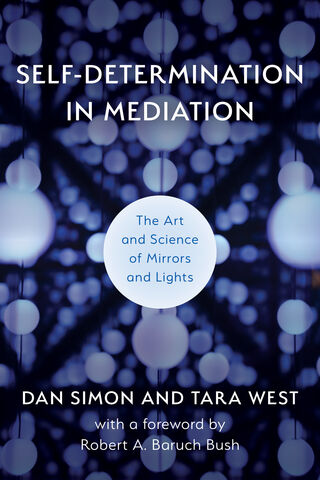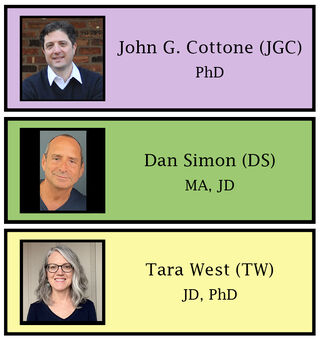Motivation
Mediation With a Therapeutic Bent
When mediators prioritize self-determination, empowerment results.
Posted November 15, 2022 Reviewed by Michelle Quirk
Key points
- Mediation can take many forms, but when self-determination is prioritized the process, as well as the outcome, it can be therapeutic.
- Self-determination is the capacity to make decisions for oneself; this distinguishes mediation from other dispute-resolution processes.
- Mediation focused on self-determination prioritizes three basic psychological needs—autonomy, relatedness, and competence.

When most people hear the word "mediation," they typically conjure images of a cold legal proceeding in a sterile conference room, focused on obtaining practical solutions to a given conflict (unless, of course, they misheard and thought it was "meditation" that was being discussed, in which case they might imagine people sitting cross-legged on yoga mats chanting "om"). But for Dan Simon, MA, JD, and Tara West, JD, Ph.D., authors of Self-Determination in Mediation: The Art and Science of Mirrors and Lights, mediation is a warm, growth-inducing process that looks more like psychotherapy than anything you might see in a law office.
Simon and West recognize that mediation often raises issues that are usually only confronted in psychotherapy—like self-sabotage, vicious cycles, spiteful resistance, and what family systems theorists call "the problem-maintaining solution"—and, for this reason, they've written a book to help mediators take a more therapeutic approach to their work. Central to this approach, and to their book, is a concept called "self-determination," akin to a sense of agency, and helping clients develop self-determination is key to making mediation work for all parties involved.
I had a chance to interview Dr. Simon and Dr. West about their book and came away impressed and inspired.

JGC: What was your motivation to write this book?
DS: We believe mediation has the potential to make a really big difference for people in conflict, with effects going far beyond the dispute itself, but only when the mediator supports party self-determination.
TW: Most mediators agree that self-determination is what distinguishes mediation from other dispute-resolution processes, but not all mediators agree about what it means or looks like in practice. We wanted to explore what self-determination could mean and why that mattered.
JGC: So, what does self-determination mean to you?
DS: For us, self-determination is akin to agency—there’s a psychological dimension to it. So it’s not only about having the freedom to make your own choices; it’s about how you feel when you make the choice. Are you feeling confused and unsure, or are you feeling clear and confident?
When we’re in conflict, we often feel overwhelmed and incapable of handling the situation. And we really don’t like how we’re relating to the other person. We don’t like how they’re treating us or how we’re treating them.
TW: Essentially, our basic psychological needs are not being met. According to a theory of motivation known as self-determination theory [Ryan & Deci, 2017], humans have three basic psychological needs: autonomy, relatedness (or feeling socially connected), and competence. And all three of these needs are being interfered with when we’re in a state of conflict.
So what we really need in that state is to regain our sense of agency. Then we can start feeling clearer and more capable of making our own good choices, which often involve becoming more open to the other person in the conflict.
JGC: So, as mediators, how do you help people in conflict regain their sense of agency?
DS: We put every possible choice in their hands throughout the process and we support their choices. This gives them the opportunity to see that they are able to make choices and to start feeling clearer and more competent to continue to make choices they can feel good about.
JGC: What does this look like?
DS: This is where the subtitle of our book comes in, “The Art and Science of Mirrors and Lights.” Everything we do is aimed at giving people a chance to see more clearly themselves, each other, the situation they’re in, and their opportunities to make choices.
TW: Practically speaking, this largely involves putting their words and actions back into the room, such as by repeating back to each party what they’ve said. We reflect what we heard them say using many of the same words they used and a similar energy or intensity they used.
JGC: How does that help?
TW: In the heat of conflict, people have trouble hearing themselves and each other. When we reflect what someone has said, it gives them an opportunity to think about it and possibly say more. They now have a chance to gain clarity about where they are and what they want to communicate. Meanwhile, the other party has a chance to hear it again—our reflection gives them some breathing room to take it in more deeply.
JGC: What else do you do?
DS: We also summarize what the parties have said over the course of the conversation. In this way, we’re illuminating the conversation as a whole and how each person sees things in relation to the other.
TW: We also shine a light on the parties’ opportunities to make choices about the process. For example, after a summary, we might say, “Would you like to talk more about any of the topics you just discussed? Or maybe there’s a new subject you want to focus on? Or would now be a good time to take a break?”
JGC: When I think of mediation, I think of it as something that helps people come to an agreement or settle a case. Does your process do that?
DS: Yes, but we don’t focus on that. By simply supporting people where they are rather than trying to get them anywhere, they’re often better able to reach agreements that work well for them, in a way they can feel good about.
TW: So, while another process might also end in an agreement, the conflict isn’t necessarily resolved. If I sign a deal, but don’t feel like I was making my own choices, or I don’t understand where the other party was coming from, or I don’t feel like I handled it competently, I’m not really going to be at peace. It’s also possible the agreement will fall apart down the road—either because I’m not feeling good about it or because it doesn’t actually work for me.
JGC: At what age do you believe people are capable of the psychological responsibilities of self-determination?
TW: We see self-determination as existing on a continuum and believe that everyone has the potential to gain more of it, within limits. So, even a 5-year-old can become more capable of making choices such as what to wear to school that day or what to have for breakfast, but no amount of support will give them the maturity or life experience they would need to responsibly make large, consequential decisions.
JGC: Can people use this information to resolve their own conflicts, without a mediator?
DS: Sure. Understanding our basic psychological needs can help us notice when our own needs aren’t being met, and when others’ aren’t being met. We could probably prevent a lot of conflicts simply by doing what we can to meet our own and others’ needs for autonomy, relatedness, and competence.
And one way to meet the other person’s needs is to nonjudgmentally reflect back what we heard them say, especially when we feel tempted to respond in an angry or judgmental way. This helps them hear themselves think, and it starts to heal the connection—we’re showing that we care about the other person’s experience and perspective.
TW: But this can be difficult in the midst of conflict, so we might need to get our own needs met first. One way would be to take a break and center ourselves with a few deep breaths. Taking this step, while knowing that we’re going to reflect the other person, can help us start to feel more confident and less overwhelmed. We now have a plan, and we’re making a choice we can feel good about.
References
Ryan, R.M., & Deci, E.L., (2017). Self-Determination Theory: Basic Psychological Needs in Motivation, Development, and Wellness. New York: Guilford Press, 2017.




